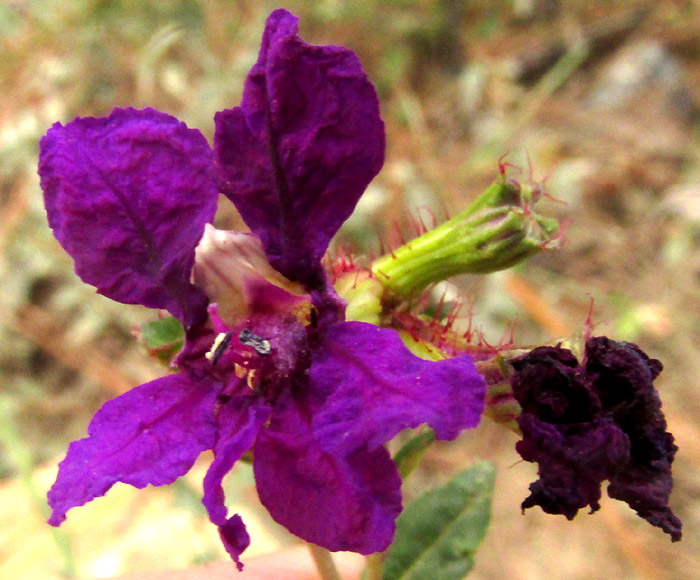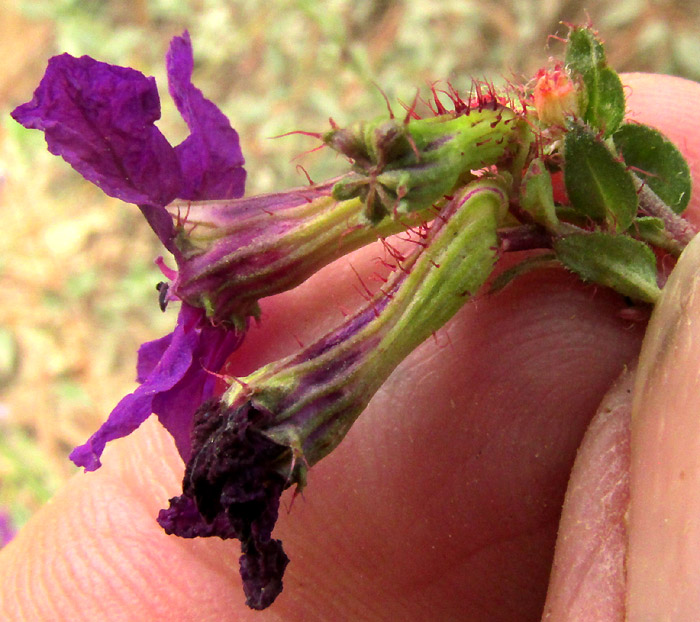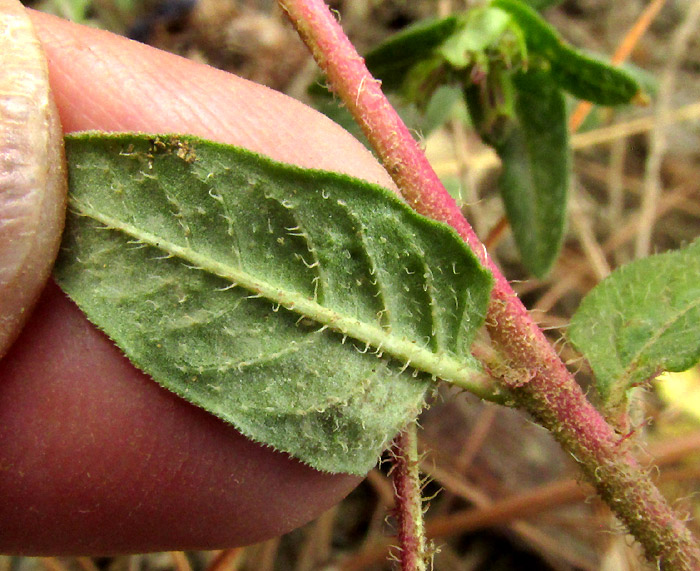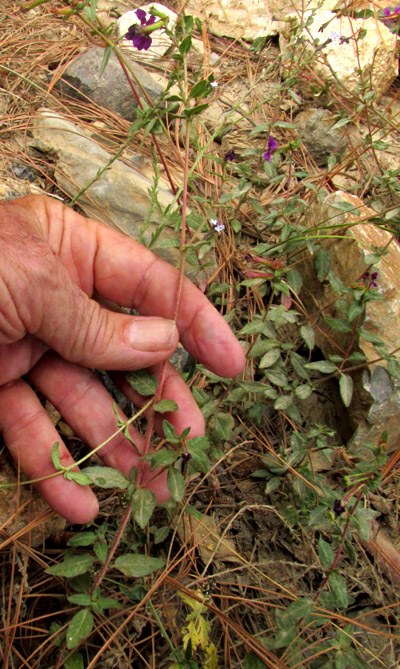Excerpts from Jim Conrad's
Naturalist Newsletter
Entry from field notes dated June 30, 2023, taken along small gravel road about half a km west, across valley, of El Suspiro about 1 straight-line km NW of El Doctor; in the mountains of east-central Querétaro state, municipality of Cadereyta de Montes, 12 straight-line kms due east of Vizarrón de Montes but much farther by twisting roads; elevation ~2600m (~8500 ft), Querétaro, MÉXICO, (N20.85563°, W99.58686°)
CUPHEA AEQUIPETALA

Along a road passing through pine/oak forest, the above herbaceous, knee-high, spindly, diffusely branched and somewhat reclining wildflower bore several thumbnail-size, dark purple flowers. In the above picture, the crumpled item at the lower right is a wilted blossom past its prime; above the two open flowers is a club-shaped, green, unopened floral tube. Wildflower admirers will recognize that the bilaterally symmetrical blossom's two erect petals, widely separated at their bases, above four close-together lower petals directed downward, is an unusual configuration. One of the four lower petals is malformed. Unseen inside the floral tube are eleven stamens, which is an unusual number. Here's how the petals arise atop the floral tube:

The floral tubes, which are pale green below but turning purple above, are not simply calyxes formed into long cylinders. Stamens arise from the floral tubes' interior walls, so floral tubes are thought of as a fusion of stamen filaments with the calyx's lower part. Above you can see sharp-tipped, triangular sepal-like calyx lobes of different lengths atop conspicuously 12-ribbed floral tubes. Notice that the wilted lower flower's floral tube base produces a backward-projected, rounded bulge, or spur. The tall, red, thick-based hairlike trichomes arising along the floral tube also are noteworthy.
All these somewhat unusual features combine to distinguish the genus Cuphea, a member of the Loosestrife Family, the Lythraceae, and native to the warmer parts of the Americas. Several Cuphea species are well known and admired as wildflowers and garden species, and certain species have commercial uses, such as the seeds providing cooking oil. To fix in your mind the "Cuphea theme, you might enjoy comparing the above flowers with some displaying the same structure but in different proportions, on the Cuphea gaumeri we saw in the Yucatan. Besides the stubbier flowers, that species' leaves were of a different size and texture than our plants', which are shown below:

Our roadside Cuphea also was much less composed and more "weedy looking":

About 260 species of Cuphea are recognized. Often the species are known as simply cupheas, but some of them may be called cigar plants or waxweeds. The genus name Cuphea is derived from the Greek word κυφος (kyphos), meaning "bent," "curved," or "humped," apparently referring to many species' somewhat curved floral tubes, and/or the spur, or hump, often appearing at floral tube bases.
The 2006 study by Shirley Graham and others entitled "A Phylogenetic Study of Cuphea (Lythraceae) Based on Morphology and Nuclear rDNA ITS Sequences," concluded that the genus Cuphea arose in South America, spread northward, and that Mexico is a secondary center of Cuphea diversification. Consequently, Mexico is home to numerous species. In our upland, central Mexican region known as the Bajío, and immediately surrounding areas, 19 species have been documented.
In our area, if you have a diffusely growing, leaning Cuphea with flowers arising in clusters with small leaves at flower bases (as shown atop this page), the flowers' petals and upper floral tubes are dark purple, the blossoms' two top petals are longer than 5mm (3/16 inch), the floral-tube lobes are markedly unequal in size, the flowers' spurs are rounded and not slender, and the floral tube itself is slender like ours, you have CUPHEA AEQUIPETALA. At least, that's the name commonly used, and currently accepted by the Kew Plants of the World database. The GBIF database currently describes that name as a synonym for Cuphea nitidula.
Cuphae aequipetala, occurring throughout Mexico's highlands south into Honduras, has no commonly used English name. It's found in disturbed, open areas, especially along roads and at field edges. The Flora del Bajío describes Cuphae aequipetala as one of Mexico's most widely distributed and collected Cuphea species.
In Mexico, as the online Biblioteca Digital de la Medicina Tradicional Mexicana tells us, the most commonly used name for Cuphea aequipetala is hierba del cáncer, or "cancer plant," indicating its traditional use for treating cancer. Flowers and leaves are boiled, then the tea drunk, or applied topically to skin sores and tumors. In certain places it's used for inflammations, including baby rashes, and infections. For various internal pains, drinking the tea three times a day is advised. Often the plant is brewed with other medicinal plants such as hierbamora (various black nightshade species) and romero (Rosemary). Many more uses also are mentioned.
In fact, the 2014 study by Juan Francisco Palacios-Espinosa and others entitled "Evidence of the anti-Helicobacter pylori, gastroprotective and anti-inflammatory activities of Cuphea aequipetala infusion," concludes that "Cuphea aequipetala is a promising native herb in an integral therapy for the treatment of bacterial or non-bacterial gastric ulcer because it possesses some anti-inflammatory properties, as well as exhibits good gastroprotective and antibacterial effects."